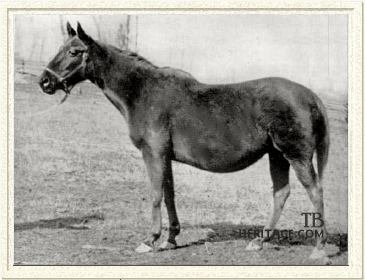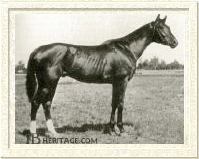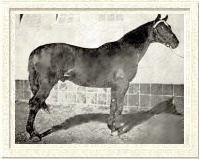|
|
Mannie Gray

|
|
 |
|
|
Mannie Gray has gone down in breeding history as one of the most influential American mares. Her genes have been carried by leading sires, classic winners, countless stakes winners, and an American Triple Crown champion traced his ancestry directly to her in the female line. Quite a feat for the little black mare who was virtually useless on the racetrack.
Mannie Gray was sired by Enquirer, who was a very good racehorse and one of the first American Thoroughbreds to reveal an affinity between the blood of Lexington and Leamington. He was from the first American crop of the imported English stallion Leamington, as was champion Longfellow. Enquirer's dam was Lida, by Lexington. Aristides, the first winner of the Kentucky Derby, was another example of this Leamington - Lexington daughter cross, as were such standout runners as Parole, Susquehanna, Saunterer, and Onandaga. Enquirer defeated Longfellow in the Phoenix Hotel Stakes and later took the measure of Belmont Stakes winner Kingfisher in the Robins Stakes at Monmouth Park. It took a while for Enquirer to make a name for himself as a stallion, Mannie Gray being one of his earlier offspring. But a few years after her birth came Falsetto, runner-up to Lord Murphy in the Kentucky Derby and victor over Spendthrift in both the Travers Stakes and the Kenner Stakes.
Mannie Gray's dam was Lizzie G., by the Lexington son, War Dance. She produced three foals by Enquirer -- Mannie Gray; Goodnight, two years younger than Mannie Gray and described as one of the fastest horses of his generation; and Faustus, a good sire, whose son, Bonnie Joe, was broodmare sire of the storied Kentucky Derby champion Black Gold.
Lizzie G. was inbred, with the stellar broodmare Reel and the great American sire Boston each appearing twice within her first three generations. Her sire, War Dance, was by Lexington (by Boston), and out of Reel. Her dam was a daughter of Lecomte, who was by Boston and out of Reel. In addition, her fourth dam was Fandango, a half-sister to Reel. Her match with Enquirer brought the resulting foal, Mannie Gray, another line of Lexington through Enquirer's dam.
Mannie Gray hailed from a female line developed by General Thomas Wells at his Wellswood Stud in Louisiana. The General bred Reel from imported Galopade and imported Glencoe. Her son, War Dance, by Lexington, was one of the Wellswood horses displaced by the Civil War when Louisiana was overrun. The stallion was taken to the Texas ranch owned by General Wells, along with several other horses, including an unnamed bay filly by Reel's son Lecomte and out of Edith, a mare whose second dam was the aforementioned half-sister to Reel, Fandango. During the war the old general died, and after the hostilities ended, his horses were returned to Wellswood and sold. Several of the mares had given birth to foals in Texas, and one of the foals that made the trip back to Louisiana was Lizzie G., foaled in 1867, from the Lecomte daughter. She was bought by Colonel George Garner as a breeding prospect and sent to be boarded in Kentucky. It was there, in 1874, that she foaled Mannie Gray.
Mannie Gray, despite the heavy concentration of quality racing bloodlines, did not inherit any real racing talent. She was purchased by General A. Buford, a wealthy Kentucky horseman who had once been a co-owner, with Ten Broeck, of the mighty Lexington. Mannie Gray was a plain black filly, small and stocky. She ran only eight times, at the age of three, and won once, a purse for all ages at Lexington over 3/4 of a mile, which she won by 20 lengthsin 1:16, beating twelve others; she also placed second in a mile race at Nashville, and ran third twice in two other races. General Buford did not keep her as a broodmare, selling her to Kentucky breeder Major Barak Thomas, the master of Dixiana Farm outside Lexington.
Mannie Gray in the Stud
During her long life as a broodmare at Dixiana, Mannie Gray produced twelve foals, six colts and six fillies. One filly died as a yearling, and given the performance of several of Mannie Gray's daughters as broodmares, this filly's death must be counted as a loss. Of her eleven surviving foals, six of these were stakes winners.
Two of Mannie Gray's sons, Sir Knight, by Fellowcraft, and Bannerol, by King Ban, did not race, and neither amounted to anything as stallions. Swiftfoot, a son by Himyar, failed to win, and he, too, failed to make a mark as a sire. Ten Strike, a son by Ten Broeck, won the Tennessee Derby and 26 other races in his six years on the turf, mostly at 1 1/2 miles, beating some good stakes winners, but he was a gelding. Freemason, by Fellowcraft, won the Bartow Stakes at Morris Park at age 2, but failed to place again that year, and at age 3 won one of his fifteen races, over 5 1/2 furlongs. He was sold to Germany.
|

Top Racehorse and Sire, Domino
|
|
Her son Domino, by Himyar, a sleek dark bay with two hind socks, was foaled when Mannie Gray was seventeen. He was a full brother to Correction, Mannie Gray's best running filly, a high class sprinter, who was still winning at New York tracks when Domino was dropped in the spring of 1891. Purchased by Foxhall Keene at the Tattersalls yearling sales in New York for $3,000, he went on to become the top juvenile of his year, unbeaten in his nine races, and at ages three and four proved himself the fastest horse of his day at distances up to a mile. Retired to James Keene's Castleton Stud, he got only twenty foals before dying at age 6. They included Belmont winner and influential sire Commando; Epsom Oaks winner Cap and Bells; Jockey Club Stakes winner and important sire Disguise; and influential broodmares Noonday, Pink Domino, Runaway Girl and Running Stream. His line thrives today via descendents of Commando's son, Colin, which include Champion Ack Ack and his son, leading sire Broad Brush.
|
| Foals of Mannie Gray |
| Name |
Sire |
Notes |
| Ten Strike b. g. 1881 |
Ten Broeck |
Won Tennessee Derby; Sea Beach R.R. Stakes, in all 27 wins between ages 3 and 9. |
| Sir Knight ch. c. 1882 |
Fellowcraft |
Unraced. |
| Bandala ch. f. 1883 |
King Ban |
Won Ladies Stakes at Jerome Park, Mermaid Stakes at Sheepshead; 3rd dam Audacious (1916, Suburban HC, Carter HC twice); 4th dam Zev (1920), and of sisters Edith Cavell and Florence Nightingale (1922) |
| Bannerol br. c. 1884 |
King Ban |
Unraced |
| Lady Reel b. f. 1886 |
Fellowcraft |
Won Beacon Stakes and 5 other races to age 4. Dam of Hamburg (1895, Brighton Cup, Great Trial St, Flash St, Lawrence Realiation St, Sire); 3rd dam Yankee Witch (1914, Spinaway St) |
| Madame Reel ch. f. 1887 |
Fellowcraft |
Unraced. |
| Correction b. f. 1888 |
Himyar |
Won 38 races, including Toboggan HC; dam of Yankee (1899, The Futurity St.), 2nd dam of Haste (1923, Withers St, Grand Union Hotel St, Saratoga Special) and of Carnation (1921, French 1,000 Guineas) |
| Freemason ch. c. 1890 |
Fellowcraft |
Won Bartow Stakes. |
| Domino br. c. 1891 |
Himyar |
Won The Futurity St., Great Trial St, Great American St, Matron St., Withers St., and others, unbeaten at age 2. Sire. |
| Unnamed b. f. 1892 |
Himyar |
Died 1893 |
| Swiftfoot b. c. 1893 |
Himyar |
Ran unplaced. |
| Mannie Himyar br.f. 1894 |
Himyar |
Unraced. Second dam of Nedana (1922, Gazelle HC, Carter HC), and of Ariel (1925, Youthful St., Saratoga Special). Tail-female ancestress Swing and Sway and Twilight Tear. |
Mannie Gray's daughters were better racers than her sons, with the exception of Domino, and virtually each one of her daughters were influential broodmares. Bandala, by King Ban, was her first daughter,foaled in 1883. She won the Mermaid Stakes at Sheepshead and the Ladies Stakes at Jerome Park, in all winning five of her twenty races at ages 2 and 3. As a producer, her own offspring were nothing special, but her daughter, Alabana, by Himyar, produced sire Jim Kelly. Mannie Gray's granddaughter, Courtplaster (from Masetto daughter Set Fast), by Persimmon's full brother, imported Sandringham, had two daughters who proved to be important producers. They were Miss Kearney, by Planudes, and The Nurse, by Yankee.
Miss Kearney foaled champion colt Zev, by The Finn. Zev was a champion at two, when he took the Grand Union Hotel Stakes, the Futurity, and the Hopeful Stakes. At three, he was a classic winner, accounting for the Kentucky Derby and the Belmont Stakes. He also captured several other races, including the Withers Stakes, the Lawrence Realization, the Queens County Handicap, and he defeated Epsom Derby winner Papyrus in a special match run at Belmont Park.
The Nurse was inbred to Mannie Gray; her sire, Yankee, was out of Mannie Gray's daughter, Correction. The Nurse was a broodmare for the Walter Jeffords stable, and to the cover of Man o' War, she foaled the champion sisters Florence Nightingale and Edith Cavell. Florence Nightingale, foaled in 1922, captured the Coaching Club American Oaks enroute to her crown as champion three-year-old filly. Her sister, Edith Cavell, one year younger, was an even better racefilly, for she not only captured the Coaching Club American Oaks, but other races such as the Latonia Oaks, the Bowie Handicap, the Astoria Stakes, and the Pimlico Cup, which she won twice over males. Unfortunately, neither of these fillies were successful as broodmares.
Mannie Gray's next daughter, Lady Reel, by Fellowcraft, was foaled in 1886. She was won six races, most under a mile, between ages two to four, including the Beacon Stakes. She was more famous as the dam of champion colt and leading sire, Hamburg. Bred by J.E. Kittson and foaled at the fabled Elmendorf Farm near Lexington, the colt was sold as a yearling to John E. Madden and trained by him as well. A stocky bay colt with a white blaze and Domino's white socks behind, Hamburg was a feisty individual with a huge appetite. He thrived on both hard work and lots of food. As a juvenile, he was sent out sixteen times, and returned to the winners' enclosure on twelve of those occasions. He was able to carry upwards of 130 pounds successfully to victory, and as a juvenile, even performed well aginst his elders. As a three-year-old, under the ownership of Marcus Daly and the training of Domino's old trainer, William Lakeland, Hamburg showed he could win at a distance. Hamburg at three won at 1-5/8 and 2-1/4 miles.
At stud, Hamburg, who unlike Domino, enjoyed a normal lifespan, was a tremendous success. He sired the good colts as Dandelion, Burgomaster, Inflexible, and the tough gelding, Borrow. His fillies were even better, as he got two female winners of the Futurity--Artful and Hamburg Belle, and the good racefilly and influential broodmare, Frizette. As a broodmare sire, Hamburg was stellar, with such fine racetrack performers and influential sires and dams as Maskette, Regret, Chicle, Dis Donc, and Golden Broom.
Lady Reel's full sister, Madame Reel, foaled in 1887, failed to make it to the races and did not make much of an impact as a producer. Mannie Gray was then sent to Himyar, and in 1888, she produced the filly Correction. Correction was one of the fastest fillies of her generation, and she was also very tough. She was primarily a sprinter, and was built like one, with powerful muscles in her hindquarters. During her career, she started 122 times, and won 38 races, including the Clover Stakes and the Toboggan Handicap.
|
 |
|
As a broodmare, she was quite successful. Her son, the royally-bred Yankee [LEFT], by Hanover, won the Futurity, and was a decent stallion, with among others, Belmont Stakes winner Joe Madden to his credit. Correction's daughter, Miss Malaprop, by imported Meddler, became the dam of Haste. By Maintenant, Haste was a speedy colt who captured the Saratoga Special, Grand Union Hotel Stakes, and the Withers Stakes. But he also had the versatility to finish third in the Belmont Stakes. At stud, Haste was mated to Prince Palatine's daughter Blue Glass, and the result was a Belmont winner--Hurry Off. Haste was also the broodmare sire of Quickly, a tough little mare who became the dam of Triple Crown champion, Count Fleet. |
Correction also produced a full sister to Miss Malaprop named Nature. Her offspring included the race filly Chiclet (Edgemere Handicap), the long-running good handicapper gelding Naturalist (Carter Handicap, Empire City Handicap and others), and Carnation, who won the French 1,000 Guineas. It was this filly that kept the Correction branch of Mannie Gray's family alive to produce Affirmed, who won the American Triple Crown and then went on to a long and distinguished stud career.
Mannie Gray's last recorded foal, and last by Himyar, was the filly Mannie Himyar, foaled in 1894. Never raced, this filly founded her own branch of the Mannie Gray family. Her son by Hanover, a colt named Mentor, became the grandsire of Wise Counsellor, a fine racer who defeated Epinard in 1924 and then became a good sire.
Mannie Himyar's daughter by Adam, Adana, was a good producer. Her daughter Nedana, by Negofol, captured the Gazelle and Carter Handicaps, and produced the colt Swing and Sway, by Equipoise. A winner of the Whitney Handicap and placed in the Brooklyn, Saratoga, and Carter Handicaps, Swing and Sway sired Saggy, a good enough colt to take the measure of Citation on one occasion, and who later sired Carry Back, a Kentucky Derby and Preakness champion.
Adana's son, Ariel, by Eternal, was a speedster. He captured the Youthful and Saratoga Special Stakes as a juvenile, and went on at stud to sire 34 stakes winners, including the filly Planetoid, later dam of Grey Flight, one of the most important American broodmares of the last half century.
Adana had another good daughter, the filly Ladana, by Lucullite. She was a good juvenile performer, capturing the Adirondack and Clover Stakes. Her daughter by Blue Larkspur, Lady Lark, produced Twilight Tear, North American Horse of the Year in 1944, winning the honor over colts. At stud, she produced the major stakes winners A Gleam and Bardstown.
Mannie Gray died at the age of twenty-two in 1896. She was buried beside the entrance gate of Hira Villa Farm, which Major Thomas had bought after selling Dixiana. The mare Hira had already been buried on the other side of the gate. Sadly, neither mare had her resting place adorned with a marker of some kind. Later, when Domino died, he was interred beside Hira, his grave topped with a large memorial. There was every intention of relocating Mannie Gray's bones to rest beside her son. Whether or not that ever took place is a mystery, as there is no record of it. But wherever her mortal remains lie, her blood still flows in some of racing's best.
--Elizabeth Martiniak
|
|
|
|

